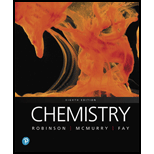
Concept explainers
Interpretation:
Whether compound I or compound II that has a higher temperature associated with phase transition from solid to liquid has to be explained.
Concept introduction:
Liquid crystals are defined as a phase in which substance exhibits properties of both liquids and solids. Liquid crystal flow like liquid but their arrangement of molecule as well as intermolecular forces is like solid.
Liquid crystal molecules are made up of six-membered rings with on terminal polar group, a linkage group and a side chain of carbon atoms. Each carbon atom in liquid crystal molecules has trigonal planar geometry.
The molecules are rigid. The rigidity is increased due to presence of double-bonded linkage groups such as
The terminal polar groups exhibit strong intermolecular forces such as strong dipole-dipole interaction or dipole−induced dipole interaction and hydrogen bond.
Types of liquid crystal are as follows:
- Nematic Liquid crystal.
- Smectic Liquid crystal.
1. Nematic Liquid crystal: The molecules in the nematic phase are in same direction and can move around freely very much like that of liquid. In this, the axis is parallel but the ends are not aligned.
2. Smectic Liquid crystal: The molecules in the smectic phase are perpendicular to the plane and are aligned in layers. In these, long axis is parallel and also their ends are aligned.
Want to see the full answer?
Check out a sample textbook solution
Chapter 11 Solutions
CHEMISTRY-W/MASTERING CHEMISTRY ACCESS
- Baking Explain why the baking instructions on a boxof cake mix are different for high and low elevations.Would you expect to have a longer or a shorter cookingtime at a high elevation?arrow_forwardWhat is the difference between a chemical and physical change? What is the difference between an intermolecular force and an intramolecular force? Explain why it takes more energy to break an intramolecular force than it does an intermolecular force. Define viscosity. Describe what surface tension is and how you know that water has a higher surface tension than alcohol. If a substance has a high viscosity, then it has strong intermolecular forces. For example, in the investigation we did, we found that room-temperature corn syrup had stronger intermolecular forces/higher viscosity than the hot corn syrup because it took longer for it to pour out of the beaker. Describe cohesion and adhesion and how they relate to your everyday life. Substances with high boiling, melting, and freezing points have stronger intermolecular forces. Four types of intermolecular forces: dispersion forces, hydrogen bonds (H-O, H-F, H-N), ion-dipole, dipole-dipole Which intermolecular force exists…arrow_forwardTATTTTTTTT Study the phase change diagrams. Match the phase change diagrams with the substances. Hint...all of the diagrams are on the same scale for temperature and energy. Look at the melting point temperatures and boiling point temperatures. Diagram #1 Temperature Temperature Energy (Heat) → Diagram #3 Energy (Heat) → Temperature Temperature Diagram #2 Energy (Heat) → Diagram #4 Energy (Heat) →arrow_forward
- Which of the following statements is FALSE regarding a substance undergoing a phase change? A. The temperature vs. Heat plot shows an increasing trend B. The system maintains its temperature even upon adding or subtracting heat. C. The substance can exist in the two phases during the process. D. The process of phase change is reversible upon addition/subtraction of the same amount of heat.arrow_forwardPredict the relative boiling points of the substances in Figure 9 and rank these boiling points from the highest to the lowest. [The sign ~means approximately equal.] * a) B > D > A > C b) D > B > A > C c) C > B > A > D d) B > A ~ D > C e) The boiling points of these compounds cannot be compared with our current model.arrow_forward
 Introductory Chemistry: An Active Learning Approa...ChemistryISBN:9781305079250Author:Mark S. Cracolice, Ed PetersPublisher:Cengage Learning
Introductory Chemistry: An Active Learning Approa...ChemistryISBN:9781305079250Author:Mark S. Cracolice, Ed PetersPublisher:Cengage Learning Chemistry: The Molecular ScienceChemistryISBN:9781285199047Author:John W. Moore, Conrad L. StanitskiPublisher:Cengage Learning
Chemistry: The Molecular ScienceChemistryISBN:9781285199047Author:John W. Moore, Conrad L. StanitskiPublisher:Cengage Learning Organic Chemistry: A Guided InquiryChemistryISBN:9780618974122Author:Andrei StraumanisPublisher:Cengage Learning
Organic Chemistry: A Guided InquiryChemistryISBN:9780618974122Author:Andrei StraumanisPublisher:Cengage Learning Chemistry for Today: General, Organic, and Bioche...ChemistryISBN:9781305960060Author:Spencer L. Seager, Michael R. Slabaugh, Maren S. HansenPublisher:Cengage Learning
Chemistry for Today: General, Organic, and Bioche...ChemistryISBN:9781305960060Author:Spencer L. Seager, Michael R. Slabaugh, Maren S. HansenPublisher:Cengage Learning World of Chemistry, 3rd editionChemistryISBN:9781133109655Author:Steven S. Zumdahl, Susan L. Zumdahl, Donald J. DeCostePublisher:Brooks / Cole / Cengage Learning
World of Chemistry, 3rd editionChemistryISBN:9781133109655Author:Steven S. Zumdahl, Susan L. Zumdahl, Donald J. DeCostePublisher:Brooks / Cole / Cengage Learning





